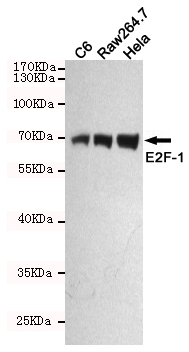E2F-1 Antibody
Purified Mouse Monoclonal Antibody (Mab)
- SPECIFICATION
- CITATIONS
- PROTOCOLS
- BACKGROUND

Application
| WB, ICC, IP |
|---|---|
| Primary Accession | Q01094 |
| Reactivity | Human |
| Host | Mouse |
| Clonality | Monoclonal |
| Isotype | IgG2b |
| Calculated MW | 70 KDa |
| Gene ID | 1869 |
|---|---|
| Other Names | Dmel\CG6376 ; Dmel_CG6376 ; drosE2F1 ; E(Sev-CycE)3A ; E(var)3-93E ; E2-promoter binding facto ; E2F 1 ; E2F transcription factor 1 ; E2F-1 ; E2f-PA ; E2f-PB ; E2f-PC ; E2F1 ; E2f1 E2F transcription factor 1 ; E2F1_HUMAN ; Evar(3)164 ; KIAA4009 ; l(3)07172 ; l(3)j3B1 ; l(3)j3C2 ; l(3)rM729 ; mKIAA4009 ; OTTHUMP00000030661 ; PBR3 ; PRB binding protein E2F 1 ; PRB-binding protein E2F-1 ; RBAP 1 ; RBAP-1 ; RBAP1 ; RBBP-3 ; RBBP3 ; RBP 3 ; RBP3 ; Retinoblastoma-associated protein 1 ; Retinoblastoma-binding protein 3 ; Transcription factor E2F1. |
| Dilution | WB~~1:500 ICC~~1:100 IP~~1:500 |
| Format | Liquid in PBS containing 50% glycerol, 0.5% BSA and 0.02% sodium azide, pH 7.3. |
| Storage | Store at 4°C short term. Aliquot and store at -20°C long term. Avoid freeze/thaw cycles. |
| Name | E2F1 {ECO:0000303|PubMed:8964493, ECO:0000312|HGNC:HGNC:3113} |
|---|---|
| Function | Transcription activator that binds DNA cooperatively with DP proteins through the E2 recognition site, 5'-TTTC[CG]CGC-3' found in the promoter region of a number of genes whose products are involved in cell cycle regulation or in DNA replication (PubMed:10675335, PubMed:12717439, PubMed:17050006, PubMed:17704056, PubMed:18625225, PubMed:28992046). The DRTF1/E2F complex functions in the control of cell-cycle progression from G1 to S phase (PubMed:10675335, PubMed:12717439, PubMed:17704056). E2F1 binds preferentially RB1 in a cell-cycle dependent manner (PubMed:10675335, PubMed:12717439, PubMed:17704056). It can mediate both cell proliferation and TP53/p53- dependent apoptosis (PubMed:8170954). Blocks adipocyte differentiation by binding to specific promoters repressing CEBPA binding to its target gene promoters (PubMed:20176812). Directly activates transcription of PEG10 (PubMed:17050006, PubMed:18625225, PubMed:28992046). Positively regulates transcription of RRP1B (PubMed:20040599). |
| Cellular Location | Nucleus |

Thousands of laboratories across the world have published research that depended on the performance of antibodies from Abcepta to advance their research. Check out links to articles that cite our products in major peer-reviewed journals, organized by research category.
info@abcepta.com, and receive a free "I Love Antibodies" mug.
Provided below are standard protocols that you may find useful for product applications.
Background
Transcription activator that binds DNA cooperatively with DP proteins through the E2 recognition site, 5'-TTTC[CG]CGC- 3' found in the promoter region of a number of genes whose products are involved in cell cycle regulation or in DNA replication. The DRTF1/E2F complex functions in the control of cell-cycle progression from G1 to S phase. E2F1 binds preferentially RB1 in a cell-cycle dependent manner. It can mediate both cell proliferation and TP53/p53-dependent apoptosis.
References
Helin K.,et al.Cell 70:337-350(1992).
Kaelin W.G. Jr.,et al.Cell 70:351-364(1992).
Shan B.,et al.Mol. Cell. Biol. 12:5620-5631(1992).
Neuman E.,et al.Gene 173:163-169(1996).
Deloukas P.,et al.Nature 414:865-871(2001).
If you have used an Abcepta product and would like to share how it has performed, please click on the "Submit Review" button and provide the requested information. Our staff will examine and post your review and contact you if needed.
If you have any additional inquiries please email technical services at tech@abcepta.com.













 Foundational characteristics of cancer include proliferation, angiogenesis, migration, evasion of apoptosis, and cellular immortality. Find key markers for these cellular processes and antibodies to detect them.
Foundational characteristics of cancer include proliferation, angiogenesis, migration, evasion of apoptosis, and cellular immortality. Find key markers for these cellular processes and antibodies to detect them. The SUMOplot™ Analysis Program predicts and scores sumoylation sites in your protein. SUMOylation is a post-translational modification involved in various cellular processes, such as nuclear-cytosolic transport, transcriptional regulation, apoptosis, protein stability, response to stress, and progression through the cell cycle.
The SUMOplot™ Analysis Program predicts and scores sumoylation sites in your protein. SUMOylation is a post-translational modification involved in various cellular processes, such as nuclear-cytosolic transport, transcriptional regulation, apoptosis, protein stability, response to stress, and progression through the cell cycle. The Autophagy Receptor Motif Plotter predicts and scores autophagy receptor binding sites in your protein. Identifying proteins connected to this pathway is critical to understanding the role of autophagy in physiological as well as pathological processes such as development, differentiation, neurodegenerative diseases, stress, infection, and cancer.
The Autophagy Receptor Motif Plotter predicts and scores autophagy receptor binding sites in your protein. Identifying proteins connected to this pathway is critical to understanding the role of autophagy in physiological as well as pathological processes such as development, differentiation, neurodegenerative diseases, stress, infection, and cancer.




